- Moose vs Elk
- Facts About Moose
- Facts About Elk
- Differences Between, Elk VS Moose
- Female Elk VS Moose
- Male Elk Versus Moose
- Moose Antlers vs Elk Antlers
- Elk Sounds VS Moose Sounds
- Elk Poop vs Moose Poop
- Moose and Elk Dimensions
- Moose and Elk Stuffed Animals
- Frequently Asked Questions, Elk vs Moose.
- Do Moose and Elk Get Along?
One of the most common questions we get when posting pictures of moose and elk is, is that a moose or an elk? The moose vs. elk debate has even been a point of conflict occasionally. People try to argue with us about which is a moose or which is an elk. This is understandable as in Europe moose are called elk occasionally. This is a quick guide to understanding the difference between moose and elk in North America!
Moose vs Elk
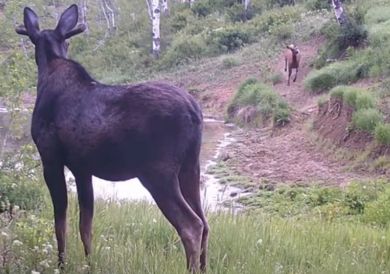
Facts About Moose
A Moose is the biggest animal in the deer species and can grow to be over 6 feet tall. These animals can also weigh up to a ton. They are normally black and/or Dark to light brown. Most moose have a flap of skin under their chins called a dewlap. (Seen in the picture above). They have antlers that usually palm and then grow points out of the palm of their antler. (See picture below) However, as the picture of the moose above shows, that is not always the case. Younger moose can grow antlers that look very similar to some elk antlers. This can confuse some trying to identify them.
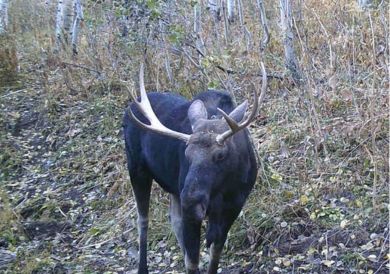
Female moose (cow) and baby moose (calf) will stay together for the first year after they are born. Females look very similar to males only their dewlap is not as defined and they don’t have antlers. Calf moose are usually very light almost reddish brown.

Facts About Elk

Elk have thick dark brown neck fur that transitions into tan body fur and ends with a white patch of fur on their rump. They are not as big as a moose. They are usually around 5 to 5 1/2 feet tall, not including their antlers. Male elk (bulls) have antlers that shed and start growing in March of every year. Female elk (cows) do not grow antlers and are usually smaller than bull elk.
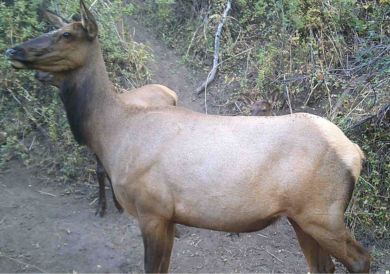
Calf elk (baby elk) are born with spots that fade in their first year of life. These spots act as camouflage and are there to help the calf elk hide from predators.
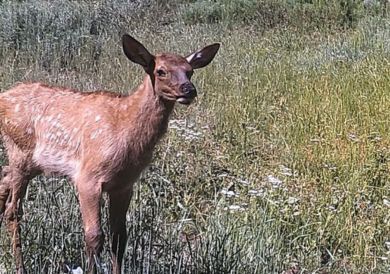
Differences Between, Elk VS Moose
The biggest difference between the two deer species is their coloring. An Elk has a dark neck like a moose but then their fur transitions into a lighter tan body with white rumps. Moose are dark brown or black everywhere except their legs which are a tan color.
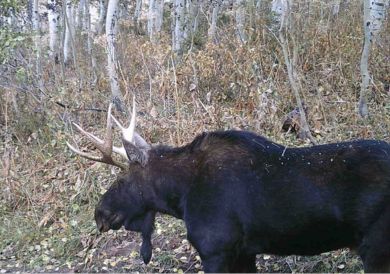
The next biggest difference between the two is their noses. An elk’s nose looks very similar to that of a dairy cow that you would see on a farm. A moose’s nose looks more like a donkey’s. This is also one of the reasons why moose are nick-named swamp donkeys.

Female Elk VS Moose
Female elk (also known as cow elk) and female moose (also known as cow moose) are both members of the deer family and share some similarities, but they also have distinct differences.
Size: Moose are significantly larger than elk. Adult female moose can weigh up to 800-1200 pounds, while female elk weigh around 400-500 pounds. Antlers: Only male moose and elk have antlers. Color: Female elk and female moose have a similar reddish-brown color, but moose tend to be darker in color, with a more blackish-brown hue.
Habitat: Elk are more adaptable to different types of habitats and can be found in a wider range of ecosystems, from forests to grasslands. Moose, on the other hand, are primarily found in boreal forests and wetlands.
Behavior: Both elk and moose are typically solitary animals, but female moose tend to be more territorial and aggressive when protecting their young, while elk are generally more social and tend to gather in herds.
In summary, female moose are much larger than female elk, moose and elk lack antlers, moose are darker in color, moose prefer boreal forests and wetlands, and female moose are generally more territorial and aggressive than female elk.
Male Elk Versus Moose
Similar to Female elk and Moose both male elk and moose are referred to as bulls. Male elk and male moose are both large and majestic members of the deer family, but they have several notable differences in terms of their appearance and behavior. Here are some of the key differences between male elk and moose.
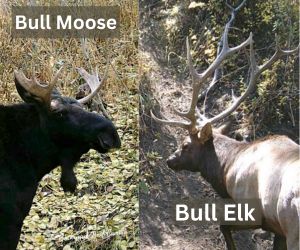
Moose are generally larger than elk. Adult male moose, also known as bulls, are among the largest land mammals in North America. They can reach a height of 6 to 7.5 feet at the shoulder and weigh between 1,200 to 1,600 pounds. Male elk, are smaller, with a shoulder height of around 4.5 to 5.5 feet and a weight range of 600 to 1,000 pounds.
Both elk and moose have impressive antlers, but there are distinct differences in their size, shape, and configuration. Moose antlers are palmate, meaning they have a broad and flattened shape with points, resembling the shape of a hand. In contrast, elk antlers are more slender and have a branching structure, with tines extending upward and outward from a main beam.
Moose Antlers vs Elk Antlers
Moose antlers and elk antlers are both impressive and distinctive features of these large members of the deer family. While they share similarities, there are notable differences between the two.


Shape: Moose antlers have a broad and flattened palmate shape, resembling an open hand with multiple points or “palms.” The antlers tend to be wider and flatter, with distinct paddles. Elk antlers, on the other hand, have a more elongated and pointed shape. They feature a main beam with several branches, or tines, that grow upward and outward.
Side note: Moose antlers can occasionally look more like elk or deer antlers as some moose antlers do not palm out like the picture above. Moose can have more elongated antlers that just have branches. (See picture below!)

Both moose and elk use their antlers primarily for mating rituals and dominance displays. During the breeding season, known as the rut, males will clash their antlers together to compete for females. The size and complexity of antlers are important indicators of an individual’s strength and dominance within the species.
Elk Sounds VS Moose Sounds
Cow Elk Sound
Bull Elk Sounds
Bull Moose Sounds
Cow Moose Sounds
Elk Poop vs Moose Poop
There is not a lot of difference between moose and elk poop. The biggest difference is the size. Because moose are bigger their poop is generally going to be bigger than an elk’s. They both look like little pellets and, like most poop, are usually brown. Below is a picture of moose poop to show the size.

Moose and Elk Dimensions
This section will compare elk and moose to common objects found in the United States of America
Elk Dimensions
Elk Height
- Honda Accord: approximately 1 Honda Accord would be equal to the height of an average elk.
- Microwaves: approximately 4 microwaves would be equal to the height of an average elk.
- Donuts: approximately 60 donuts (using an assumed height of 1 inch) would be equal to the height of an average elk.
- Cookies: approximately 119 cookies (using an assumed height of 0.5 inches) would be equal to the height of an average elk.
Elk Length
- Honda Accord: approximately 0.49 Honda Accords would be equal to the length of an average elk.
- Microwaves: approximately 6.4 microwaves would be equal to the length of an average elk.
- Donuts: approximately 32 donuts would be equal to the length of an average elk.
- Cookies: approximately 48 cookies would be equal to the length of an average elk.
Elk Weight
- Honda Accord: approximately 0.273 Honda Accords would be equal to the weight of an average elk.
- Microwaves: approximately 25.71 microwaves would be equal to the weight of an average elk.
- Donuts: approximately 7,200 donuts would be equal to the weight of an average elk.
- Cookies: approximately 14,400 cookies would be equal to the weight of an average elk.
Moose Dimensions
Moose Height
- Honda Accord: Pending on the year a Mooses shoulder is equal to 1.5 Accords stacked on top of each other.
- Microwaves: roughly 5.25 microwaves stacked on top of each other would be equal to the shoulder height of the average moose.
- Donuts: roughly 79.5 donuts would be needed to stack up to the height of an average moose.
- Cookies: roughly 157 cookies would be needed to stack up to the height of an average moose.
Moose Length
- Honda Accord: approximately 0.575 Honda Accords would be equal to the length of an average moose.
- Microwaves: approximately 7.48 microwaves would be equal to the length of an average moose.
- Donuts: approximately 37.4 donuts would be needed to line up to the length of an average moose.
- Cookies: approximately 56 cookies would be needed to align with the length of an average moose.
Moose Weight
- Honda Accord: approximately 0.364 Honda Accords would be equal to the weight of an average moose.
- Microwaves: approximately 30 microwaves would be equal to the weight of an average moose.
- Donuts: approximately 9,600 donuts would be equal to the weight of an average moose.
- Cookies: approximately 19,200 cookies would be equal to the weight of an average moose.
Moose and Elk Stuffed Animals
Stuffed animal, Moose
Stuffed animal, Moose
Stuffed animal, Elk
Frequently Asked Questions, Elk vs Moose.
- Which is bigger an elk or a moose?
- Moose are generally larger than elk in terms of both height and weight. A full-grown bull moose can stand up to 6.9 feet (2.1 meters) tall at the shoulder and weigh over 1,500 pounds (680 kilograms), while a bull elk typically stands around 4.5-5.5 feet (1.4-1.7 meters) tall and weighs between 500-700 pounds (227-318 kilograms). However, the size can vary depending on the subspecies and the specific region where they are found. Both moose and elk are impressive animals that have adapted to different environments and play important ecological roles in their respective habitats.
- Why is a moose called an elk?
- It is believed that the term “elk” was originally applied to the North American animal by European settlers who were reminded of the European elk, or moose, by its large size and imposing appearance. Over time, the term became commonly used to refer to the North American animal, and it is still used in this way today.
- Who would win in a fight between an elk and a moose?
- It’s difficult to predict the outcome of a hypothetical fight between an elk and a moose, as there are many factors that could influence the result, such as the size and strength of the individuals involved, as well as their temperament and experience in fighting. However, moose are generally larger and more aggressive than elk, and their antlers are larger and sharper, which could give them an advantage in a fight. Moose also have a hump on their shoulders that provides additional protection during fights. That being said, fights between elk and moose are rare and typically only occur during mating season or when defending territory. It’s never a good idea to approach or provoke wild animals, as they can be unpredictable and dangerous.
- Is an elk also known as a moose?
- No, an elk is not the same as a moose in North America. Although the two animals are often confused due to some similarities in their physical appearance, they are actually different species. Elk are also known as wapiti, and they are native to North America and parts of Asia. They are part of the deer family and are typically smaller than moose, with a light brown coat and a white rump patch. Moose, on the other hand, are the largest members of the deer family and are found in North America, Europe, and Asia. They have a dark brown coat and a distinctive flap of skin hanging from their neck called a dewlap. While elk and moose may look similar to some people, they are actually two distinct species with different characteristics and habitats.
- Why are moose called cows?
- In North America, the term “cow” can be used to refer to female moose, as well as female elk, and other ungulates. The term “cow” is commonly used to distinguish female moose from males, which are called “bulls”. This naming convention is similar to the use of “cow” and “bull” to refer to female and male domestic cattle.
- Is a moose bigger than an Irish elk?
- No, a moose is not bigger than an Irish elk. In fact, the Irish elk was one of the largest deer species that ever existed, and it is estimated to have stood about 2.1 meters (7 feet) tall at the shoulder and weighed up to 700 kg (1500 pounds), making it significantly larger than a moose.
Do Moose and Elk Get Along?
Generally speaking, moose and elk rarely are around each other except in passing. Moose are generally more solitary and elk generally stick together in small or large groups. Occasionally, they do meet up. Check out this video of a bull moose and a female elk playing at a waterhole together!
Trail Camera Tips
If you need help catching these animals on trail cameras, Click below for a quick guide on how to get animals to walk in front of your cameras!
If you would like to learn more about moose vs elk click the buttons below!